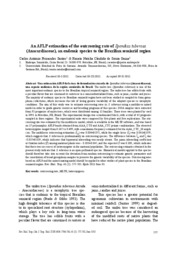An AFLP estimation of the outcrossing rate of Spondias tuberosa (Anacardiaceae), an endemic species to the Brazilian Semiarid region.
An AFLP estimation of the outcrossing rate of Spondias tuberosa (Anacardiaceae), an endemic species to the Brazilian Semiarid region.
Autoria: SANTOS, C. A. F.; GAMA, R. N. C. de S.
Resumo: The umbu tree (Spondias tuberosa) is one of the most important endemic species to the Brazilian tropical semiarid region. The umbu tree has edible fruits with a peculiar flavor that are consumed in natura or in a semi-industrialized form, such as jams, candies and juices. The majority of endemic species to Brazilian semiarid region have not been studied or sampled to form germplasm collections, which increases the risk of losing genetic variability of the adapted species to xerophytic conditions. The aim of this study was to estimate outcrossing rates in S. tuberosa using a multilocus mixed model in order to guide genetic resources and breeding programs of this species. DNA samples were extracted from 92 progenies of umbu trees, which were distributed among 12 families. These trees were planted by seed in 1991 in Petrolina, PE, Brazil. The experimental design was a randomized block, with a total of 42 progenies sampled in three regions. The experimental units were composed by five plants and five replications. The outcrossing rate was estimated by the multilocus model, which is available in the MLTR software, and was based on 17 polymorphic AFLP bands obtained from AAA_CTG and AAA_CTC primer combinations. The observed heterozygotes ranged from 0.147 to 0.499, with a maximum frequency estimated for the AAA_CTC_10 amplicon. The multilocus outcrossing estimation ( ) was 0.804±0.072, while the single-locus ( ) was 0.841±0.079, which suggests that S. tuberosa is predominantly an outcrossing species. The difference between and was -0.037±0.029, which indicates that biparental inbreeding was nearly absent. The mean inbreeding coefficient or fixation index ( ) among maternal plants was - 0.103±0.045, and the expected was 0.108, which indicates that there was no excess of heterozygotes in the maternal population. The outcrossing estimates obtained in the present study indicate that S. tuberosa is an pen-pollinated species. Biometrical models applied to this species should therefore take into account the deviation from random outcrossing to estimate genetic parameters and the constitution of broad germplasm samples to preserve the genetic variability of the species. Outcrossing rates based on AFLP and the mixed-mating model should be applied to other studies of plant species in the Brazilian semiarid region.
Ano de publicação: 2013
Tipo de publicação: Artigo de periódico
Unidade: Embrapa Semiárido
Palavras-chave: AFLP, Caatinga, Genetic variability, Melhoramento genético, Planta nativa, Sistema reprodutivo, Spondia tuberosa, Umbu, Variabilidade genética
Observações
1 - Por padrão são exibidas publicações dos últimos 20 anos. Para encontrar publicações mais antigas, configure o filtro ano de publicação, colocando o ano a partir do qual você deseja encontrar publicações. O filtro está na coluna da esquerda na busca acima.
2 - Para ler algumas publicações da Embrapa (apenas as que estão em formato ePub), é necessário ter, no celular ou computador, um desses softwares gratuitos. Sistemas Android: Google Play Livros; IOS: iBooks; Windows e Linux: software Calibre.
Acesse outras publicações
Acesse a Base de Dados da Pesquisa Agropecuária (BDPA) para consultar o acervo completo das bibliotecas da Embrapa.

